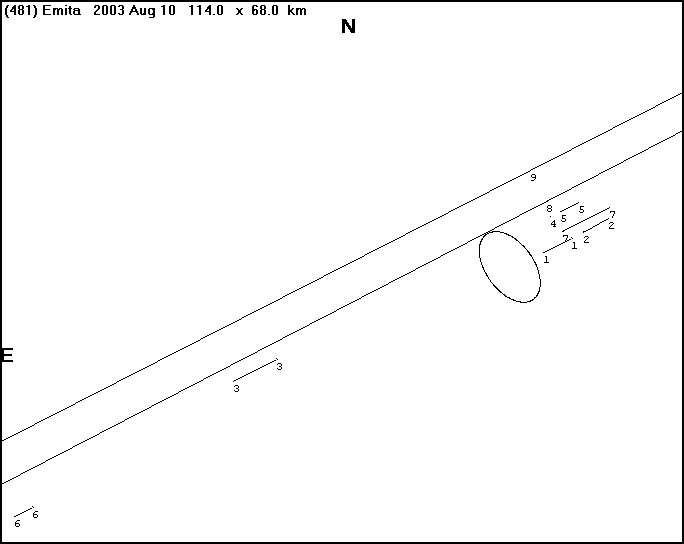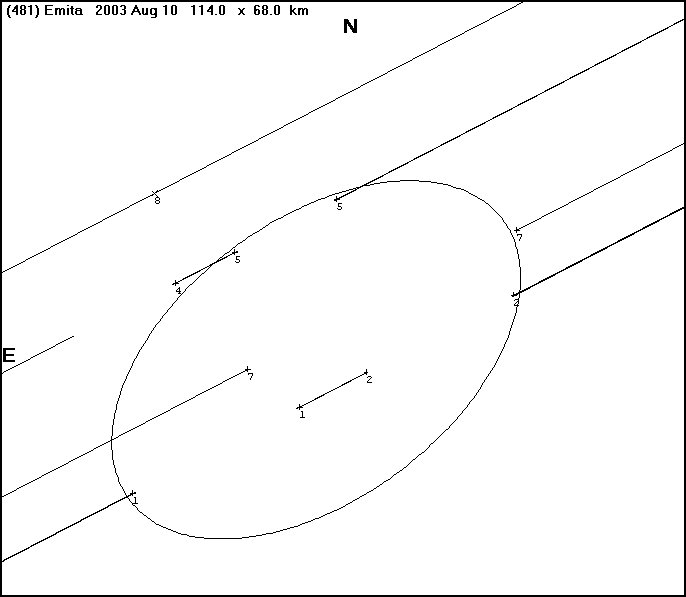BRIEF SUMMARY (Prepared by Dave Herald):
On the evening of Aug 10 many members of the Canberra Astronomical Society, and at least one observer in New Zealand, attempted to observe the occultation by Emita. In Canberra, Pat Purcell and Albert Brakel did an excellent job of planning for the event, doing some site surveys well beforehand to ensure a good distribution of observers across the path. MANY thanks to their good effort.
Leading up to the event, the skies were perfectly clear - giving an expectation that we would be getting a fantastic result. However about 3 hours before hand cirrus cloud started moving in. As a result, many observers (myself included) failed to locate the star field. However several did, and reported some results - and this gave rise to tantalising hope that all was not lost because of the cloud.
Attached are two plots of the observations. Emita A shows all the observations. The lines represent the star when it was invisible - or the whole path for Miss events. Emita C shows the clustered observations. Here the lines represent when the star was reported as visible.
Emita A:
Emita C:
Explanations:
Conclusion:
There are several possible explanations for the observations. But if the 'Occams razor' principle is applied, the simplest/most likely explanation is that the observations are heavily affected by cloud. This is not to say that the possibilities that events were caused by one or more moons, or by the asteroid being double or extremely odd-shaped or small, can be positively excluded. Rather, the MOST LIKELY explanation (by far) is that the observations are cloud affected.
This conclusion is the more disappointing given the hope that something was salvageable from the observations - given the disappointment of the cloud coming in. For any asteroidal occultation, correlation of the various observations is an important factor in the analysis. This can only be the more-so when the observing conditions are marginal - as in this case. In the end, I think that all we can reasonably say about this event is - c'est la vie, and better luck next time!
OBSERVATIONS AS REPORTED BY THE OBSERVERS:


1. The distant observations. These events (including the one reported by Tabur, which is not plotted)
'could' be caused by satellites of the asteroid. However, it is noteworthy that all these 'events'
occurred at different locations, and would imply the existence of more than one moon. Also the size of
the moon would be comparable to the main asteroid, and at a distance where they would be noticeable
with normal techniques - suggesting that the moon explanation is very unlikely.
2. The clustered observations. Some possible explanations are:
a. the observations of Purcell, and Brakel, were 'grazing' events. However
the maximum predicted duration of this occultation was 7.7 secs. The
duration of graze events should be much less than this - but the reported
durations were of the order of 8 secs. Graze phenomena is not an
explanation.
b. a double asteroid. One could fit ellipse to the two pairs of events of
Brakel and Purcell. But the observation of Murphy would have the star
visible when it was behind one or other of the double-asteroid.
c. An odd-shaped asteroid - shaped like the letter 'X' - with Brakel and
Purcell seeing occultations by the top and bottom two arms, and Murphy
seeing an occultation by the waist. An interesting asteroid shape, with a
diameter rather smaller than the IRAS diameter.
d. Only one of the pairs of events by both Brakel and Purcell are real.
Brakel prefers his last event over the preceding two. A fit can be made to
the last events of Brakel and Purcell, and including the observation of
Murphy. The asteroid would be 80 x 45 km - VERY much smaller than the IRAS
116km circular diameter.
e. The data is affected by cloud, so that it is not possible to determine
which events are caused by cloud, and which (if any) are caused by the
asteroid. It is also interesting that Tabur reported a 2-sec event which
seemed instantaneous yet he thought was due to cloud.
Observer : Albert Brakel
Observing site name : Ryan's Road
Longitude (East +ve) : +149 10' 01"
Latitude (South -ve) : -35 46' 43"
Height above Sealevel (metres) : 815
Sky Transparency : Poor
Star Image Stability : Poor
Other Conditions:
(Wind, Clouds, Lights, etc.) : Cirrus with bright moonlight made observing very difficult. Only first and
some second magnitude stars were visible to the unaided eye, and Alpha Librae
had to be located with binoculars. From there I was able to star-hop to the
target star.
| Estimated |
Universal Time | Reaction | Accuracy, Remarks
h m s | Time (sec) |
Started Observing : 10:01:20
First Disappearance At : 10:02:52.1 1.5 sec
First Reappearance At : 10:02:56.0 0.7
Second Disappearance At : Seen but not timed
Second Reappearance At : 10:03:25.7 0.7
Third Disappearance At : 10:03:26.9 0.8
Third Reappearance At : 10:03:29.5 1.5
Stopped Observing : 10:06
ADDITIONAL COMMENTS: As noted above, conditions were marginal, and the target
star was often near the limit of direct vision, requiring averted vision to be
used. This explains the large PEs (which have NOT been applied to the timings).
The second disappearance was not timed, as I was taken by surprise to see it
after the first 4 sec extinction sometime earlier, and at first I thought it was
a seeing fluctuation due to the cirrus in the appalling conditions - then recorded
the reappearance just in case it might not be. I can't be certain of the duration
of the second extinction. My impression was that it was longer than the third
extinction that followed, but only by a little. If pressed for an estimate, I
would say about 2.5 - 3 sec.
ADDITIONAL COMMENTS 17 AUGUST 2003:
I agree with Dave Herald that in the circumstances no *reliable* conclusion
about Emita can be drawn from the data of the 3 observers. However, I
clearly saw my second and third extinctions separated by a reappearance, and
the fact that Patrick Purcell saw something remarkably similar at almost the
same times despite our ~40 km separation strongly indicates that there is
something peculiar about this asteroid, whatever it may be. The duration of
Grant Murphy’s second extinction may appear to be at odds with mine and
Patrick’s, but his 5 sec duration was only a rough estimate, and it may have
been greater by a couple of seconds. His inability to see a reappearance
event during this interval could be due to being in the zone of overlap or
joining of two bodies. I believe there is good reason to alert would-be
observers of future Emita occultations elsewhere in the world to watch for
multiple events, and light-curve observers should put this asteroid on their
list of targets to see if there is evidence of a binary object. If there is
an asteroid imaging program at a large telescope like the Kecks at a time
when Emita is favourably placed, then Emita should be put on the observing
program.
Observer : Patrick Purcell
Observing site name : Approximately 12 Km North of Cooma and
west of the Monaro Highway, NSW
Longitude (East +ve) : +149 07' 44"
Latitude (South -ve) : -36 09' 06"
Height above Sealevel (m) : 851
Datum : WGS84
| Estimated |
Universal Time | Reaction | Accuracy, Remarks
h m s | Time (sec) |
Started Observing : 09:57:00
Disappearance At : 10:03:23.4s 0.4s (Not applied)
Reappearance At : 10:03:26.5s 0.4s (Not applied)
Disappearance At : 10:03:27.7s 0.4s (Not applied)
Reappearance At : 10:03:30.4s 0.4s (Not applied)
Stopped Observing : 10:10:00
ADDITIONAL COMMENTS:
After a clear sunny day, high level cirrus emerged shortly after sunset and presented a uniform
'murk' which was transparent enough (from my location) to see Alpha Librae naked eye and
navigate to the target star with the main scope. The faint star to the west of the triangular
asterism which included the target star was barely visible being obscured intermittently by the
'murk'. That would have been right at my limiting magnitude. The other stars remained visible
throughout the viewing session except for the times shown above i.e. they were visible for 6
minutes before and after the event.
In the lead up to the first event, there may have been a partial fade just before the complete
disappearance but it happened too quickly for me to record. I was expecting either a very
brief disappearance or a complete miss from my location. I was very surprised to see a
second disappearance! That was totally unexpected on my part and after packing the gear
I rang Peter Bobroff at the Michelago Inn to let him know so he could pass on the information
to Dave Herald.
Although it is tempting to dismiss these observations as unreliable because of the weather,
it is worth noting that the final 3 times correspond (within a second or 2) to the times and events
recorded by Albert Brakel. Albert recorded an interim reappearance of about 1.1s and I saw a
transient reappearance of some 1.4s prior to the final disappearance. As cirrus cloud has an
altitude of some 13 Km, it is difficult to explain how it could have generated almost simultaneous
(pseudo) 'events' for observers so far separated (40 or more Km - or more than 2 horizon
distances) looking at the same star. However, I did not see the first event which Albert recorded.
It will be very interesting to see how the New Zealand observations compare with the CAS ones.
I predict that video timings of future occultations by Emita will eventually corroborate our
observations.
Observer : Grant Murphy
Observing site name : Billilingara Rd, ~8 km south of Bredbo NSW
Longitude (East +ve) : 149 08 22
Latitude (South -ve) : -36 01 26
Height above Sealevel (metres) : ?
Datum : ?
COMMENTS:
Observing conditions very difficult, Moon illuminated cloud made the star difficult to detect.
Star sometimes not visible with direct vision. However, I felt there were two disappearances, but
I wasn’t able to get decent timings on either.
The second was somewhere around the predicted time, for perhaps 5 seconds between 10h 03m 15s
and 10h 03m 30s.
The first was less certain but I felt there was an absence of perhaps 2 seconds somewhere
between 10h 02m 25s and 10h 02m 30s.
There were absences that I attributed to the poor conditions and perhaps thicker areas in the
cloud. But the two described above seemed to be of a different nature somehow.
I understand Pat Purcell got some reasonable timings and for two disappearances, so perhaps
my observations might tally with his.
OTHER ATTEMPTS:
The track of this event passed across New Zealand just south of Hamilton, across Rotorua and Taupo,
and across Gisborne. One observer in Hamilton reported a miss. One observer in Gisborne experienced
a computer failure at the critical moment. And no other reports from within the track have been
received from New Zealand.
Other observers who reported being clouded out:
CANBERRA
Mike Dower (Spence)
John Morland (Curtin)
Andrew White (Curtin)
Bob Johnston (Hughes)
John Blank (Mawson)
Steve Crouch (Theodore)
MONARO HIGHWAY REGION
Peter Bobroff (Michelago)
Michael Nelmes (Michelago)
Tom Hayes (Bredbo)
Dave Herald (Numeralla rest area 36 04' 35"S, 149 09' 31"E)
OTHER AREAS
John Howard (Major’s Creek NSW 35 deg 32’ S, 149deg 40’ E, in the path)
Margaret Turner (Tuross Head NSW 36 04’ 00” S, 150 08’ 00”E).
Dave Gault : Bungendor-Braidwood Rd-turnoff to Duckfield Flat
Longitude (East +ve) : 149 40 57.11
Latitude (South -ve) : -35 15 39.71
[Total Occultations]
[Grazing Occultations]
[Planetary Occultations]
[Jovian Satellite Eclipses]
[Timing Occultations]
[Reporting Observations]
[Coming Events]
[Software]
[About Us]
[Publications]
[Membership]
[Links]
[Top of Page][Return to Home Page]